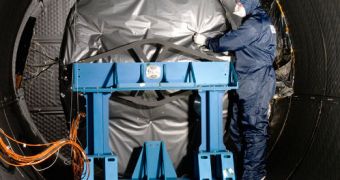Experts in the United Kingdom announce the successful completion of the Mid-InfraRed Instrument (MIRI). The device, which will go on the James Webb Space Telescope, is the first of the observatory's complex suite to be finished.
It also represents the key European contribution to the NASA-led project. At this point, the fate of the project hangs in the balance, since Congress is pondering proposals to cancel the advanced telescope.
However, until otherwise specified, all the research groups and organizations involved with the project are carrying on with their work. Recently, experts in the United States finished polishing all 18 hexagonal mirror that will make up the JWST's primary light detector.
MIRI will be used in conjunction with the main mirror, for studying faint and cold objects such as small comets orbiting the Sun, exoplanets that are still forming, stellar nurseries inside dust-clogged portions of space, and distant galaxies that evolved when the Universe was a fraction of its current age.
The instrument will be able to do this only if it operates at a constant temperature of just 7 degrees Kelvin above absolute zero, or -266° Celsius. The main structure and optics of MIRI were constructed by a consortium of European institutions.
Over the past few weeks, MIRI was subjected to a wide variety of harsh conditions, similar to those it will experience during launch and extended operations in space. The JWST will be placed about 1.5 million kilometers away from Earth, in the L2 Lagrangian point.
The instrument was tested at RAL Space in Oxfordshire, an installation operated by the UK Science and Technology Facilities Council. “It is inspiring to see MIRI working extremely well at its operating temperature after so many years in development,” official Gillian Wright explains.
“The test campaign has been a resounding success and the whole MIRI team can be very proud of this magnificent achievement,” adds the expert, who is the leader of the MIRI European Science Team and the principal investigator for the European portion of the project.
The JWST is an international endeavor including NASA, the European Space Agency (ESA) and the Canadian Space Agency (CSA). Each of the three organizations is contributing critically-important components to the most advanced space telescope ever built.
“Future users of JWST and MIRI are looking forward to learning more about the detailed performance of the instrument once the test results are analyzed further in the coming months,” says ESA JWST project scientist Peter Jakobsen.
“The experience gained by the MIRI test team throughout this campaign has sown the seeds for a rich scientific harvest from the JWST mission,” he adds, saying that the recent accomplishment marks a significant milestone in this ambitious project.

 14 DAY TRIAL //
14 DAY TRIAL //